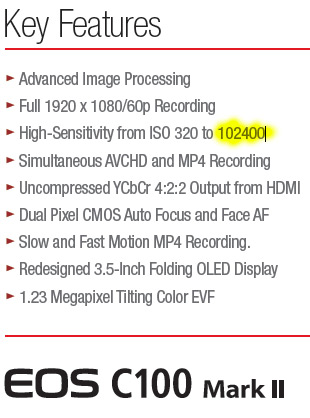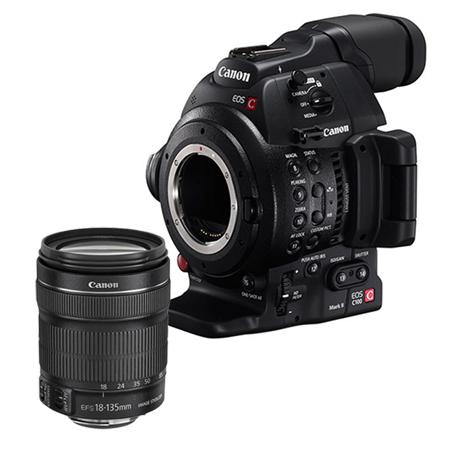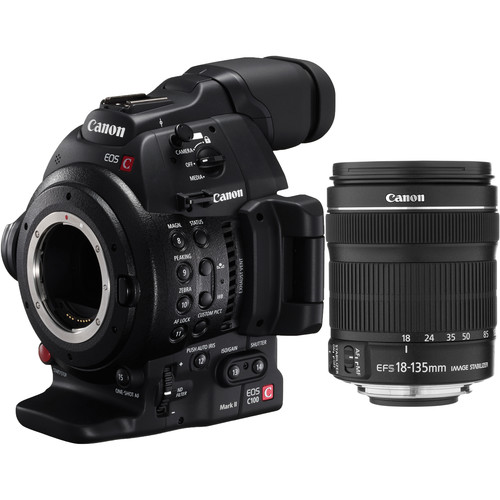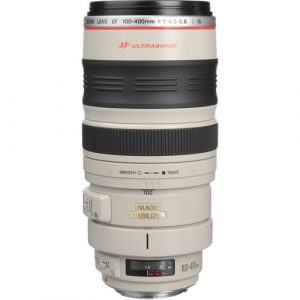Canon EOS C100 Mark II Cinema EOS Camera (Body Only)
Canon EOS C100 Mark II Cinema EOS Camera with Dual Pixel CMOS AF
The Canon EOS C100 Mark II Cinema EOS Camera with Dual Pixel CMOS AF is Canon’s updated version of the C100 designed for event videographers, documentarians, and independent filmmakers. It incorporates the continuous autofocus function compatible with all Canon autofocus lenses, using Dual Pixel CMOS AF technology. This new feature provides faster and more accurate autofocusing to assist users when operating with small crews.
Key Features
- Super 35mm 8.3MP CMOS Sensor
- EF Mount
- Canon 17-55mm EF-S Mount Lens
- 1080p Touchscreen Display with 4K Input
Canon EOS C100 Mark II Cinema EOS Camera with Dual Pixel CMOS AF
Dual Pixel CMOS AF Technology
Powerfully Evolved HD Freedom.
The Canon EOS C100 Mark II Digital HD Camera offers all of the advantages of its predecessor while adding advanced new imaging and operational features by popular demand. Optimized for one-person use and compatible with the full range of Canon EF, EF-S, and EF-mount CN-E Cinema lenses, this greatly evolved camera integrates the same Emmy®-Award winning Canon Super 35mm CMOS Sensor used in all of Canon’s Cinema EOS cameras, but now replaces the Canon DIGIC DV III Image Processor with the more sophisticated Canon DIGIC DV 4 Image Processor. In addition to improved RGB video processing, the camera’s dual codec capability supports simultaneous AVCHD and MP4 recording, including 59.94P capture along with slow and fast motion recording. Dual Pixel CMOS AF and Face AF, wireless FTP video transfer, a built-in Canon Log LUT, GPS support and support for an extensive range of workflows, are additional operational features that have been added. A re-designed 270-degree rotating 3.5-inch OLED panel, and a tiltable large-size EVF with large-size eyecup, further empower the camera operator.
The compact, redesigned, lightweight body of the Canon EOS C100 Mark II Digital HD Camera has also evolved, and now includes a built-in microphone, START/STOP buttons clearly labeled in red, transparent covers on its twin SD card slots, improved battery insertion and removal, and an increased number of assignable buttons. Add to this its built-in ND filters, removable rotating pistol grip, removable top handle with twin XLR inputs, built-in stereo mic, and audio controls, and the Canon EOS C100 Mark II emerges as a powerfully evolved Super 35mm Digital HD camera designed to serve your quest for greater freedom of creative expression in HD video production.
Features
Canon Super 35mm CMOS Sensor
The EOS C100 Mark II Digital HD Camera employs the same single Super 35mm Canon CMOS image sensor as the rest of the Cinema EOS camera family and includes the same innovative strategies that have established the outstanding image performance of these cameras. This 8.3 megapixel sensor maximizes the size of the individual photosite – each of which deploys two photodiodes to ensure high speed removal of accumulated charge, which in turn helps elevate the effective sensor dynamic range. Allied with innovative Canon signal extraction strategies that enhance the sensor signal to noise performance allows unprecedented elevation of the ISO setting in this professional Super 35mm camera, while always protecting its dynamic range.
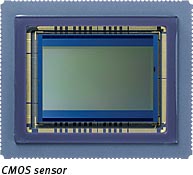
Canon DIGIC DV 4 Image Processor
The four 1920 x 1080 HD R Gr Gb B video components from the image sensor are pre-processed and then sent to the DIGIC DV 4 processor for advanced video processing. This includes separate interpolation of the sparsely sampled R and B HD components to form full frame 4K for each. The two green HD components are also interpolated to form a single full frame 4K Green component. These three 4K RGB components are then down-sampled to create a set of YCC 422 HD components that have high MTF, improved edge transitions, low false color moiré, and enhanced overall color reproduction. These components are further processed preparatory to sending them to the AVCHD and MP4 codecs.


Simultaneous AVCHD and MP4 Recording
The EOS C100 Mark II Digital HD Camera enables users to record in both the AVCHD and the MP4 recording formats in a variety of bit rates (up to 28 Mbps and 35 Mbps, respectively), resolutions, and frame rates, including 59.94p, to address practically any production need. Both formats have their own particular advantages. AVCHD is a professional standard that enables long-duration recording of full HD using moderate total data capacities. MP4 has advantages for Web and smartphone sharing. Both formats are easily accepted by most nonlinear editing applications. The EOS C100 Mark II camera’s dual SD card slots can record in either or both formats simultaneously and can convert AVCHD and MP4 files into smaller MP4 files for web upload.

Slow and Fast Motion Recording
The EOS C100 Mark II Digital HD Camera can provide slow and fast-motion video effects when recording in the MP4 format. Sound is not recorded, and the feature is not available during double-slot recording. Slow and fast-motion playback speeds can range from x0.4 slow up to x2.5 fast.



MP4 Conversion
This feature allows for converting an AVCHD or MP4 recording on the SD card in the EOS C100 Mark II camera’s main slot into a 3 Mbps (640 x 360) MP4 file on the SD card in the alternate slot. This gives users a smaller file that is easier to transmit. MP4 conversion is not possible for MP4 files at 35 Mbps and AVCHD files at 28 Mbps.

Redesigned 3.5-Inch OLED Panel
OLED (Organic Light-Emitting Diode) is a newer display technology that provides vivid colors, high contrast, and dramatically improved responsiveness compared to traditional LCD screens. The 3.5-inch 1.23 megapixel OLED display on the EOS C100 Mark II delivers virtually 100 percent field of view coverage, wide and faithful color range support, and improved viewing even in bright sunshine. The EOS C100 Mark II camera’s OLED screen has a new hinge design to help maximize monitoring versatility. The design allows the panel to fold shut when stowed and protect the OLED surface. It can then open 180 degrees to reveal function keys and a joystick, or open further to 270 degrees to deploy against the side of the camera and provide monitoring for directors, producers, or other production personnel.

1.23 Megapixel Tilting Color EVF
Larger and totally redesigned from what was featured on its predecessor model, the EOS C100 Mark II camera’s EVF (Electronic ViewFinder) uses a 0.45 inch 1.23 megapixel color panel surrounded by a large professional-style eyecup like the one used on the Canon EOS C300 and EOS C500 Cinema cameras. In addition, the new EVF has a 68 degree tilt angle, allowing it to be used more effectively in a variety of shooting situations.

Dual Pixel CMOS AF
A standard feature of the EOS C100 Mark II Digital HD Camera, Dual Pixel CMOS AF (AutoFocus) ingeniously deploys the two photodiodes within each sensor Photosite to facilitate a powerful phase difference detection that provides measurement data that ultimately controls the EF lens focusing system helps ensure that proper focus is always maintained, even in unpredictable “run and gun” news or documentary-type shooting situations. Dual Pixel CMOS AF operates within the center portion of the frame and is compatible with more than 100 Canon EF lenses.
Face AF ModeFace AF mode detects and focuses on human faces. Both the Dual Pixel CMOS AF and Face AF capabilities give camera operators more freedom to concentrate on composing their shots and paying attention to potentially unpredictable shooting environments.


Push Auto IrisPush Auto Iris automatically adjusts the aperture of the lens to quickly and easily maintain proper exposure, even in situations where lighting changes frequently.
The following EF Lenses are compatible with Face AF and Auto Push Iris:
- EF-S 10-18mm f/4.5-5.6 IS STM
- EF-S 18-135mm f/3.5-5.6 IS STM
- EF-S 18-55 f/3.5-5.6 IS STM
- EF-S 55-250mm f/4-5.6 IS STM
- EF 24-105 f/3.5-5.6 IS STM
- EF-S 18-135mm f/3.5-5.6 IS USM
59.94p Frame Rate
By popular demand, the EOS C100 Mark II HD Digital Camera can capture 1920 x 1080 HD video at a 59.94p frame rate (59.94p is available in MP4 mode at 35 Mbps and in AVCHD at 28 Mbps). This frame rate can provide captured video with a very “smooth” look that is useful for sports and news applications.
Wireless FTP Video Transfer
MP4 and AVCHD video files (and still images) can be wirelessly transferred to a selected FTP server. This feature is particularly useful for transferring time-critical video for news and for backing-up files. The feature uses the 5GHz band for quick, reliable file transfers. Up to 100 files can be selected to transfer at one time.
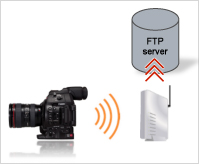
Built-In Microphone
A monaural “mono” microphone is built into the body of the EOS C100 Mark II Digital HD Camera for the capture of reference audio, for spoken notes, or as an aid to synching sound in post. This microphone works only when the removable top handle with twin XLR inputs is not attached.

Built-In Canon Log LUT
Many filmmakers prefer to shoot in Canon Log to protect the integrity of the total dynamic range of which the image sensor is capable, which, in turn, can provide greater latitude in post-production grading processes. As the picture is being monitored during Canon Log-enabled shooting, however, the image seen will not accurately represent its final “look”. A built-in LUT (Look-Up Table) in the EOS C100 Mark II can be applied to facilitate viewing the video live on a monitor connected to the camera’s HDMI® output in a more visually appealing Wide DR (Dynamic Range) or BT.709 (television standard) color space. The Canon Log LUT feature can be turned on or off in the camera’s menu.
Red Record Buttons
There are three start/stop record buttons on the EOS C100 Mark II Digital HD Camera (one on the front of the camera, one on the removable pistol grip, and one on the detachable top handle) and all are red for bright visibility. Besides aiding with quick identification, this industry-standard color helps reduce the chance of accidentally stopping a recording.

New Ergonomic Re-Design
The EOS C100 Mark II Digital HD Camera features a compact design for comfortable use by a single operator. Subtle but important modifications for smoother operator comfort include indentations around control buttons and a recessed power switch.

Outstanding Low Light Sensitivity and Wide Dynamic Range
The combined performance of the camera’s Canon Super 35mm CMOS sensor and DIGIC DV 4 Image Processor achieve a very high signal-to-noise ratio that enables recordings with great detail and dynamic range even in minimal light. This advanced performance yields a maximum ISO speed of 102,400 and a wide dynamic range with up to 12 stops.

Full Manual Control and Focusing Aids
Digital filmmakers preferring complete manual control have that ability with the Canon EOS C100 Mark II Digital HD Camera. Shooters can also create, save, and recall custom picture settings, camera functions, and display options. Highly effective built-in Focus Aids to confirm critical focus can be displayed on both the tilting EVF and folding OLED monitor, including Peaking (white, red, blue, yellow) and a magnification function that can be shifted to 25 locations across the image. Also included is an Edge Monitor feature, which shows red and green displays at the bottom of the OLED panel with three red focus-check areas shown. The green waveform shows overall focus of the image while the red waveform shows the focus status of the focus-check boxes. Through this dynamic focus feedback technology shooters can intuitively tune focus or quickly change the zone of focus.

Removable Pistol Grip and Top Handle with XLR Inputs and Stereo Mic
The removable top handle on the Canon EOS C100 Mark II Digital HD Camera integrates a built-in tally light, stereo microphone, dual XLR audio inputs for stereo recording, and a mic mount. Audio is captured in 16-bit 48 kHz linear PCM format or Dolby Digital. A compact array of audio-level dials and channel/input switches built into the handle (under a hinged clear plastic protective cover) enables shooters to select signals from the built-in stereo mic or mics attached to the XLR inputs and adjust the gain independently on a channel-by-channel basis. Users can also power a wide range of audio-capture devices with the XLR inputs phantom power supply.

HDMI® Out with Time Code
The Canon EOS C100 Mark II Digital HD Camera includes a screw-locking HDMI connector for output of live HD video from the camera to monitors or other devices. The camera’s HDMI signal features superimposed SMPTE time code for attachment to recorders or other third-party devices.

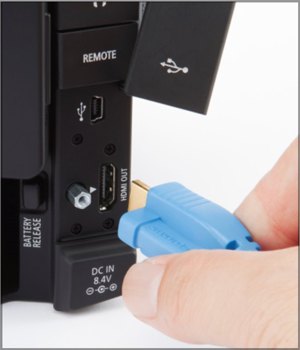
Canon RC-V100 Remote Controller
An optional Canon RC-V100 Multi-Function Remote Controller can be connected to the camera via its remote control cable to adjust image quality and other settings from a distance. This can also be a handy feature when shooting from a crane, jib arm, or mounted remotely in some other inaccessible location.
Canon GP-E2 EOS GPS Receiver
An optional Canon EOS GP-E2 GPS Receiver can be connected to the camera using a USB cable to provide precise location and time information during shooting. This capability can support editing and archiving functions.

Specifications
Effective Pixels
Total Pixels
Sensor Type
Sensor Size
Scanning System
Number of Sensors
Filter
Imaging Processor
Interchangeable Lens System
ND Filter
Iris Dial
Push Auto Iris Control
Auto Iris Control
Peripheral Illumination Correction
Exposure Modes
Push Auto Iris Control
Auto Iris Control (STM lenses)
Metering Modes
Gain
Fine Setting -6dB to 24dB in 0.5dB increments
ISO
320 to 102,400* in 1-step or 1/3 step increments* When the sensitivity is expanded
ND Filter
Exposure Compensation/AE Shift
Shutter Modes
Speed setting can be set in 1/3 or 1/4 stop increments
Shutter Speed Range
59.94i/: 1/60 to 1/2000 in 1/4 or 1/3 stops; SLS: ¼, 1/8, 1/15, 1/30; CS: 59.94 Hz – 250.51 HzPF30: 1/30 to 1/2000 in 1/4 or 1/3 stops; SLS: ¼, 1/8, 1/15; CS: 29.97 Hz – 250.51 Hz
23.98p/PF24: 1/24 to 1/2000 in 1/4or 1/3 stops; SLS: 1/3, 1/6, 1/12; CS: 23.98 Hz – 250.51 Hz
50i: 1/50 to 1/2000 in 1/4 or 1/3 stops; SLS: 1/3, 1/6, 1/12 1/25; CS: 50.00 Hz – 250.51 Hz
PF25: 1/25 to 1/2000 in 1/4 or 1/3 stops; SLS: 1/3, 1/6, 1/12; CS: 25.00 Hz – 250.51 Hz
Shutter Angle Settings
59.94i: 360, 240, 216, 180, 120, 90, 60, 45, 30, 22.5, 15, 11.25PF30: 360, 240, 216, 180, 120, 108, 90, 60, 45, 30, 22.5, 15, 11.25
23.98p/PF24: 360, 345.6, 288, 240, 180, 172.8, 144, 120, 90, 86.4, 72, 60, 45, 30, 22.5, 15, 11.25
50i: 360, 300, 240, 180, 150, 120, 90, 60, 45, 30, 22.50, 15, 11.25
PF25: 360, 300, 240, 180, 150, 120, 90, 75, 60, 45, 30, 22.50, 15, 11.25
Iris (Aperture) Range
Focus Settings
Autofocus System
(a) Dual Pixel CMOS AF (screen center)
(b) TTL-Video Signal Sensing System (contrast detection system) when Face AF is selected
Signal System
Compression
Color Space
Maximum Bit rate
MP4: 35 Mbps
Recording Options
AVCHD:MP4:
Recording Time
Recording Media
File Format
MP4
File System
Maximum Clip Number
Recording Format
28 Mbps & 24 Mbps Modes: Linear PCM; 2-Channel; 16-Bit; 48 kHz
All Other Modes: Dolby Digital 2chMP4:
MPEG-4 AAC-LC; 2-Channel; 16-bit; 48 kHz
35-17 Mbps: 256 kbps
Less than 4 Mbps: 128 kbps
Built-in Microphone
Stereo Microphone in Handle Unit
External Audio Inputs
External microphone terminal: (3.5 mm diameter)
Recording Channel Selection
CH1/CH2: The CH1 signals are allocated to the L output channel, and the CH2 signals are allocated to the R output channel.
CH1/CH1: The CH1 signals are allocated to the L output channel, and the CH1 signals are allocated to the R output channel.
CH2/CH2: The CH2 signals are allocated to the L output channel, and the CH2 signals are allocated to the R output channel.
ALL CH/ALL CH: Signals obtained by mixing the CH1 and CH2 signals are allocated to the L and R output channels.
XLR Mic Trimming
Limiter
Recording Level Adjustment Range
Separate controls for internal and externally connected microphones.
Phantom Power
Headphone Adjustment
Built-in Speaker
1KHz Tone
Playback
(2)Special Playback: Fast Forward: 5x Speed>15x speed>60x speed>5x speed… Fast Reverse: 5x speed>15x speed>60x speed>5x speed… Frame Forward: 1-frame increments Frame Reverse: In 0.5 second increments (1-GOP increments) Skip Playback: The first image located according to the number of times the skip button has been pressed is output, and played back. In temporary stop mode, the display moves to the start of the clip and pauses. Rec. Review: Rec review is executed by pressing the rec review button while in camera mode. By selecting whether the play back from the start of the last clip on the selected media or play back the last 4 seconds of that clip. When continuous recording has been performed so that the recording extends from one care onto the other, only the images on the card in the current slot are played. Slow Playback: None
Slow and Fast Motion Recording
Available in MP4 Mode Only. This function achieves a fast or slow motion effect by recording at a frame rate different from the one used during playback. The following recording frame rates can be selected using the camera’s video quality and frame rate settings. No sound is recorded. 59.94 Hz mode (MP4)50.00 Hz mode (MP4)
Special Recording Functions
Photo Recording Mode
Waveform Monitor
Gain: 1x/2x
Vectorscope
Gain: 1x/5x
Exposure/Focus Aids
Pre-Record
Scan Reverse
Time code
*59.94(i/P>/29.97P mode in 59.94 Hz mode only
Time Code Modes
Auto White Balance (AWB)
White Balance Presets
Custom Functions
Custom Display
Assign Buttons
Color Bars
(59.94 Hz mode) & EBU/SMPTE (50.00 Hz mode)
Minimum Subject Illumination
(f/1.2 lens, 24dB, PF29.27, 1/30s)50.00 Hz Mode: 0.25 Lux
(f/1.2 lens, 24dB, PF25.00, 1/25s)
Sensitivity
[1920×1080/59.94i, ISO 640 (0dB), 2000 lux, reflectance ratio of 89.9%]50.00 Hz mode: F10
[1920×1080/50.00i, ISO 640 (0dB), 2000 lux, reflectance ratio of 89.9%]
S/N Ratio
[1920×1080/PF29.97, Canon Log Base sensitivity ISO 850 (Dynamic Range 800%)]50.00 Hz Mode: 54dB (Typical)
[1920×1080/PF25.00, Canon Log Base sensitivity ISO 850 (Dynamic Range 800%)]
Dynamic Range
*With Canon Log Gamma or Wide DR Gamma: 800%
*ISO 850 or above – gain 2.5dB or above
Viewing Angle Adjustment
Diopter Adjustment Range
EVF Adjustments
Type
Display Adjustments
Time code In/Out
HDMI
Audio Input Terminal
3.5mm Microphone terminal on main body
Headphone Jack
Remote Terminals
Power Terminal
DC in: 8.4V
Battery
Compact Power Adapter
Tripod Adapter
Tripod Adapter Base
Zoom Remote Controller
Dimensions
Approx. 5.8(w) x 6.9(h) x 6.7(d) in. (147(w) x 174(h) x 169(d) mm)
Camera Body plus Grip plus Eyecup:
Approx. 7.4(w) x 7.4(h) x 8.6(d) in. (188(w) x 189(h) x 219(d) mm)
Camera Body plus Thumb Rest plus Handle Unit & Eyecup:
Approx. 7.4(w) x 11.0(h) x 13.1(d) in. (188w) x 280(h) x 334(d) mm)
Main Unit Weight
Temperature and Humidity
Operating requirements: -5°C to 45°C, 60% (relative humidity)
Language Support
Time and Date
World Clock
† Prices and specifications subject to change without notice. Actual prices are determined by individual dealers and may vary.
How To Buy

| Weight | 5.5 kg |
|---|---|
| Dimensions | 14.5 × 12.0 × 12.0 cm |
| brands | Canon |





